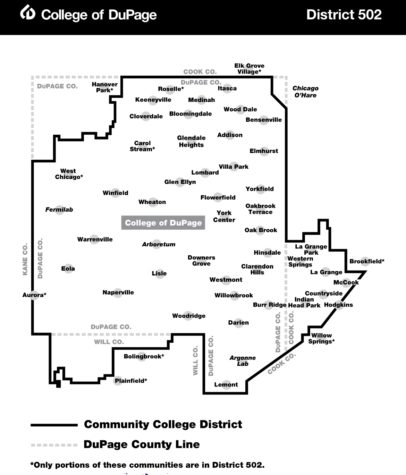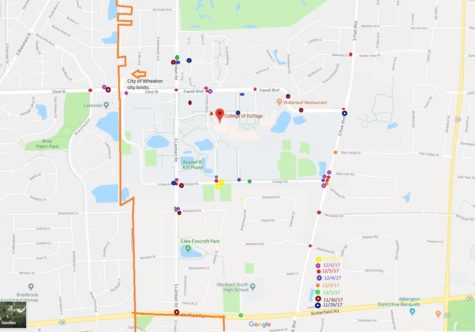Crossing the Line: Is the College of DuPage Police Department doing its job?
A College of DuPage police officer monitors the intersection of College Road and Prairie Drive.
February 2, 2018
In an effort to keep college campuses safe and secure, a vast majority of universities in the United States have managed their own police departments. In fact, The Atlantic reported that over 92% of public colleges in the US have been equipped with sworn and armed law enforcement officials. The College of DuPage, with its main campus located in Glen Ellyn, Illinois has been no exception to this statistic.
The College of DuPage (COD) has operated a fully independent law enforcement agency out of the Robert J. Miller Homeland Security Education Center. The department has utilized between two and seven police vehicles on any given day, both marked and unmarked SUV’s and pickup trucks. To that end, the department has made a multitude of traffic stops and has routinely utilized those vehicles in an effort to patrol the entirety of the school’s Glen Ellyn campus. But just how useful have these stops been to the overall safety and security of the school?
To assist in answering this question, the COD police department has posted its “Campus Incident Logs” on its website. All traffic stops have been accounted for, including the time and location of the stop. In total, roughly 62% of the agency’s traffic stops within just the 31 day timespan of the month of December were conducted within the Village of Glen Ellyn’s city limits, with a mere 32% of all stops that occurred in the same month actually taking place on university property.
All things considered, there is one Village of Glen Ellyn street that has run through the campus; Lambert Road. If it were taken into account that Lambert splits the East and West sides of the campus, the statistics changed, but only very slightly. The percentage of stops in Glen Ellyn deflated to about 60% and College of DuPage stops increased to 34% with municipal stops still grossly outweighing those on the actual campus itself.
Did that mean that the College of DuPage Police Department has been exercising its power correctly, or has the department carried too much of it and utilized that power incorrectly?

These questions have a lengthy and rather complicated answer. First, the topic of jurisdiction must be taken into account. The College of DuPage, located within the city limits of Glen Ellyn, has maintained jurisdiction in only Glen Ellyn. However, according to Lieutenant Kent Munsterman from the COD police department, this has not been the case. “The COD Police have jurisdiction throughout District 502,” Lt. Munsterman said in an email, as well as attaching a link to the map of the district.
The area within its jurisdiction has stretched just over 25 miles east to west from McCook to Aurora, as well as 23 miles north to south from Elk Grove Village to Lemont. Hypothetically, this will mean that the College of DuPage police officers have the full legal right to make a stop anywhere within that area, and it will be at the Department’s sole discretion to take such actions as they deem necessary.
Second, it has been completely lawful for COD police officers to pull over drivers on Village of Glen Ellyn roadways. They have had full discretion to pull over any vehicle that they deemed to be an active threat, but what has been the point of making stops off of university property unless that driver is assumed to be of immediate danger to the public?
As Lt. Munsterman put it, “The COD Police Department is responsible for enforcing traffic laws, including speed enforcement, on the Glen Ellyn campus of the College of DuPage. COD Police officers have often stopped vehicles for exceeding the speed limit.”
This statement seemed to conflict with the traffic stop operations of the COD Police Department. With 62% of all traffic stops that COD officers have been conducting coming on Village of Glen Ellyn streets, it appears to be clear that COD Police consistently have spent a majority of the time focused on municipal streets.
This graphic has illustrated this trend. The College of DuPage Police logs have indicated where and when each traffic stop has been conducted. This graphic utilized data from November 29 up through December 7. Each dot represented a traffic stop, and the different colors of dots reflected each date.

A chart detailing where College of DuPage Police Department officers pulled over drivers between November 29, 2017 and December 6, 2017.
After reviewing the graphic, there have been a few very densely packed areas where stops have appeared to be prevalent, one of which is at the very corner of COD’s campus but has still been considered to be outside of the geographical border of the college–College Road & Park Boulevard. Another has been at Woodcroft and Lambert, a block past the edge of the campus. According to Deputy Sharon Hood of the DuPage County Sheriff’s Office, an officer will follow a driver until it is safe to pull that vehicle over, but that will mean that the officer was timing a Village of Glen Ellyn roadway, not one on the campus of the College of DuPage.
Along with those densely populated areas, there have been three separate incidents that have occurred in Wheaton about two to three blocks outside of the campus’ westmost boundary. There also have been a handful of other outliers from the rest that have occurred a multitude of blocks outside of the actual vicinity of the university.
One last off-putting incident was the stop that occurred on the Butterfield Road entrance to Glenbard South High School–Butterfield Road x Raider Lane. Even with police following a suspect vehicle, the 1.1 mile drive from College Road to the said intersection seemed rather inappropriate. While the exact infraction had been unbeknownst to the public, one would assume that the driver must have done something absolutely crooked to warrant being tailed for that long; however, all the driver received was a verbal warning.
According to US Legal, the definition of college police has been; “sworn police officers employed by a public school district, college or university to protect the campus.” Now the question will seem clear: has the COD Police Department been doing its job?

The sign in front of the College of DuPage Police Department in Glen Ellyn, IL.
If the consideration has been that the COD Police force has been “protecting” Village of Glen Ellyn streets with these traffic stops as opposed to the COD campus, then “no” would be the simple answer to this question. The trends that the department followed seemed to indicate that, no, the COD Police Department have not been protecting the campus where they have been stationed, but instead the village and the areas surrounding it.
The COD Police Department has been exercising its discretion in cases of traffic stops and law enforcement as a whole. The Department has maintained control of an entire district that stretches a 575 square mile area, more than twice the size of the City of Chicago and 200 squared miles larger than the entire size of DuPage County.
Whether or not the College of DuPage Police Department has maintained too much control over the area in which they serve has been rather subjective. These stops, although legal, go against what the COD Police Department should accomplish. The Department should protect and serve; however, the boundaries of their jurisdiction have been murky.

































Fred • Feb 5, 2018 at 9:58 am
Poorly researched, actually look into the topic before you write 2/10
I look forward to your next sports piece.
Greg Kozlick • Mar 1, 2018 at 7:44 am
Hi Fred,
Us here at the Independent did a significant amount of research to create this piece. We tracked COPD stops for a full month, and then spent an additional month synthesizing this information into this piece. We also interviewed the Lieutenant at the university’s police department.
Thanks for taking the time to reach out.
GK
Katie • Feb 5, 2018 at 9:39 am
To the author of this article, sure you did your research on statistics and numbers of stops and location, good for you. Any chance you’ve made a traffic stop before? Watched a traffic stop from start to finish (one that you were not involved in)or asked an officer how one actually works or the dangers it entails? Do you know that when an officer initiates a traffic stop cars don’t stop on a dime? Sometimes the driver actually moves their vehicle to a safer spot away from traffic. This MIGHT, just might make the location of the stop different from where the initial violation was observed. How many people in these traffic stops were actually conducting business at COD? I think we should be concerned if there were NO traffic stops happening, before assuming that anyone isn’t doing their job, how about you put yourself in their shoes and see first hand how and what happens. I know for a fact, you’re perspective will change. Also, who from District 87 got stopped by COD Police and wanted to complain?